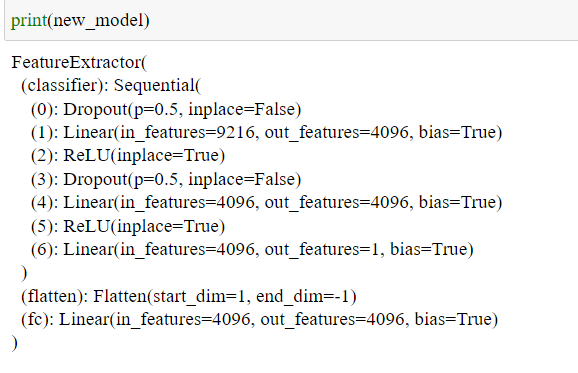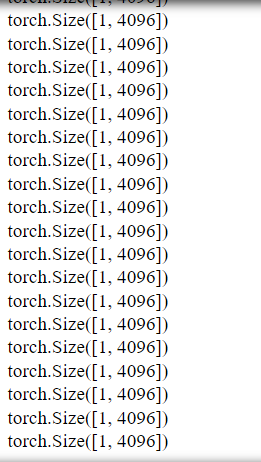I have a dataset with 4 classes A, B, C and D. After training the alexnet to descriminative between the three classes, I want to extract the features from the last layer for each class individeually. in other words, I want a vector with (number of samples in class A, 4096) and the same for B,C and D.
the code divides into some stages: load the dataset- modify the last layer in alexnet - trained_model function- trained the alexnet for all classes in the dataset- create dataloader for each class - /// should I pass each class separetly to train_model function
dataset_root = dset.ImageFolder('path root', transform=Compose([Resize((224,224)),ToTensor(), transforms.Normalize([0.485, 0.456, 0.406], [0.229, 0.224, 0.225])]))
print(len(dataset))
datasets = train_val_dataset(dataset_root)
print('number of training samples= ', len(datasets['train']))
print('number of validation samples= ', len(datasets['val']))
# The original dataset is available in the Subset class
print(datasets['train'].dataset)
dataloaders = {x:DataLoader(datasets[x], batch_size= 64, shuffle=True, num_workers=4) for x in ['train','val']}
dataset_sizes = {x: len(datasets[x]) for x in ['train', 'val']}
class_names = dataset.class_to_idx
print(dict(Counter(dataset.targets)))
x,y = next(iter(dataloaders['train']))
print(x.shape, y.shape) # The shape of a batch is (batch_size, color_channels, height, width).
print('class_names is :', class_names)
device = torch.device("cuda:0" if torch.cuda.is_available() else "cpu")
############
def train_model(model, criterion, optimizer, scheduler, num_epochs=25):
since = time.time()
best_model_wts = copy.deepcopy(model.state_dict())
best_acc = 0.0
for epoch in range(num_epochs):
print('Epoch {}/{}'.format(epoch, num_epochs - 1))
print('-' * 10)
# Each epoch has a training and validation phase
for phase in ['train', 'val']:
if phase == 'train':
model.train() # Set model to training mode
else:
model.eval() # Set model to evaluate mode
running_loss = 0.0
running_corrects = 0
# Iterate over data.
for inputs, labels in dataloaders[phase]:
inputs = inputs.to(device)
labels = labels.to(device)
# zero the parameter gradients
optimizer.zero_grad()
# forward
# track history if only in train
with torch.set_grad_enabled(phase == 'train'):
outputs = model(inputs)
_, preds = torch.max(outputs, 1)
loss = criterion(outputs, labels)
# backward + optimize only if in training phase
if phase == 'train':
loss.backward()
optimizer.step()
# statistics
running_loss += loss.item() * inputs.size(0)
running_corrects += torch.sum(preds == labels.data)
if phase == 'train':
scheduler.step()
epoch_loss = running_loss / dataset_sizes[phase]
epoch_acc = running_corrects.double() / dataset_sizes[phase]
print('{} Loss: {:.4f} Acc: {:.4f}'.format(
phase, epoch_loss, epoch_acc))
# deep copy the model
if phase == 'val' and epoch_acc > best_acc:
best_acc = epoch_acc
best_model_wts = copy.deepcopy(model.state_dict())
print()
time_elapsed = time.time() - since
print('Training complete in {:.0f}m {:.0f}s'.format(
time_elapsed // 60, time_elapsed % 60))
print('Best val Acc: {:4f}'.format(best_acc))
# load best model weights
model.load_state_dict(best_model_wts)
return model
############
Alexnet_model = torchvision.models.alexnet(pretrained=True)
# this loop will freeze all layers
for param in Alexnet_model.parameters():
param.requires_grad = False
Alexnet_model.classifier[6] = nn.Linear(Alexnet_model.classifier[6].in_features, 4)
#Compute SGD cross-entropy loss
device = torch.device('cuda' if torch.cuda.is_available() else 'cpu')
model_conv = Alexnet_model.to(device)
criterion = nn.CrossEntropyLoss()
# Observe that only parameters of final layer are being optimized as opposed to before.
optimizer_conv = optim.SGD(model_conv.classifier.parameters(), lr=0.0001, momentum=0.9, weight_decay=0.0001)
# Decay LR by a factor of 0.1 every 7 epochs
exp_lr_scheduler = lr_scheduler.StepLR(optimizer_conv, step_size=3, gamma=0.9)
model, best_model_wts = train_model(model_conv, criterion, optimizer_conv,
exp_lr_scheduler, num_epochs=256)
###############
### pick out the feature extractor:
#import trained alexnet
m.classifier[6] = nn.Linear(Alexnet_model.classifier[6].in_features, 1)
#Compute SGD cross-entropy loss
device = torch.device('cuda' if torch.cuda.is_available() else 'cpu')
model_class= m.to(device)
criterion = nn.CrossEntropyLoss()
optimizer_conv = optim.SGD(model_class.classifier.parameters(), lr=0.0001, momentum=0.9, weight_decay=0.0001)
exp_lr_scheduler = lr_scheduler.StepLR(optimizer_conv, step_size=3, gamma=0.9)
# define each class in the dataset
class_names = train_img.class_to_idx
print(dict(Counter(dataset_root.targets)))
A_dset = Subset(dataset_root, range(0, 826))
B_dset = Subset(dataset_root, range(826, 1648))
C_dset = Subset(dataset_root, range(1648, 2043))
D_dset = Subset(dataset_root, range(2043, 2870))
A_loader = DataLoader(A_dset, batch_size=1, shuffle = False)
B_loader = DataLoader(B_dset, batch_size=1, shuffle = False)
C_loader = DataLoader(C_dset, batch_size=1, shuffle = False)
D_loader = DataLoader(D_dset, batch_size=1, shuffle = False)
I confused about the next step!!. should I creat a custom train_model for each class or what


